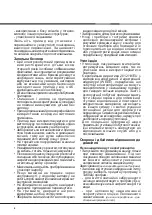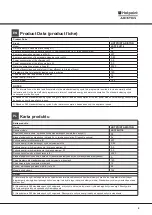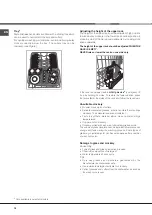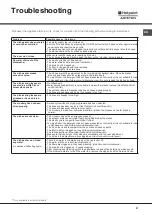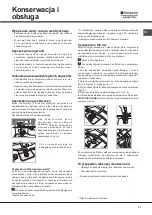
17
EN
Detergent and
dishwasher use
Measuring out the detergent
Good washing results also depend on the correct amount of
detergent being used. Exceeding the stated amount does not
result in a more effective wash and increases environmental
pollution.
The amount can be adjusted to the soil level.
In the case of normally soiled items, use approximately either
25g (powder detergent) or 25ml (liquid detergent). If tablets
are used, one tablet will be enough.
If the crockery is only lightly soiled or if it has been rinsed
with water before being placed in the dishwasher, reduce
the amount of detergent used accordingly.
For good washing results also follow the instructions shown
on the detergent box.
For further questions please ask the detergent producers.
Open the detergent dispenser using button
D
and measure out
the detergent according to the Table of wash cycles:
• powder or liquid: compartments
A
(wash detergent) and
B
(pre-
wash detergent)
• tablets: when the cycle requires
1 tablet, place it in compartment
A
and close cover
C
; when it
requires 2 tablets, place the
second tablet on the bottom of
the appliance.
Remove detergent residues from
the edges of the compartment and close cover
C
until it clicks.
The detergent dispenser automatically opens up at the right time
according to the wash cycle.
If all-in-one detergents are used, we recommend using the TABS
option, because it adjusts the cycle so that the best washing and
drying results are always achieved.
Only use detergent which has been specifically designed
for dishwashers.
DO NOT USE washing up liquid.
Using excessive detergent may result in foam residues
remaining in the machine after the cycle has ended.
To achieve the best washing and drying results, the combined
use of detergent, rinse aid liquid and refined salt is required.
We recommend using detergents that do not contain
phosphates or chlorine, as these products are harmful
to the environment.
Starting the dishwasher
1. Turn the water tap on.
2. Open the door and press ON-OFF button.
3. Measure out the detergent.
(see detergent information).
4. Load the racks
(see Loading the racks)
.
5. Select the wash cycle in accordance with the type of crockery
and its soil level
(see table of wash cycles)
by pressing the
P
button.
6. Select the wash options
*
.
(see Special wash cycles and
options)
.
7. Start the wash cycle by shutting the door.
8. The end of the wash cycle is indicated by beeps and by the
flashing of the wash cycle number on the display. Open the
door, switch off the appliance by pressing the ON/OFF button.
9. Wait for a few minutes before removing the crockery, in order
to avoid burns. Unload the racks, beginning with the lower level.
- The machine will switch off automatically during
certain extended periods of inactivity, in order to
minimise electricity consumption.
AUTO WASH CYCLES
*
:some models of dishwashers are
equipped with a special sensor which can be used to assess
the level of soiling and automatically setting the most efficient
and economic wash cycle accordingly.
The duration of the Auto wash cycles may vary due to the
operation of the sensor.
If the crockery is only lightly soiled or if it has been rinsed
with water before being placed in the dishwasher, reduce the
amount of detergent used accordingly.
Modifying a wash cycle in progress
If a mistake was made during the wash cycle selection process,
it is possible to change the cycle, provided that it has only just
begun: open the door taking care to avoid the escaping steam,
by pressing and holding the ON/OFF button, the machine will
switch off. Switch the machine back on using the ON/OFF button
and select the new wash cycle and any options desired; start
the cycle by closing the door.
Adding extra crockery
Without switching off the machine, open the door, taking care
to avoid the escaping steam, and place the crockery inside the
dishwasher. Shut the door and the cycle will begin from the point
at which it was interrupted.
Accidental interruptions
If the door is opened during the wash cycle, or if there is a power
cut, the cycle stops. It starts again from the point at which it
was interrupted once the door has been shut or the electricity
supply is restored.
*
Only available in selected models.
Summary of Contents for LSTF 9H114
Page 5: ...5 UA i i i i 2012 19 RAEE ...
Page 6: ...6 i i i 8 i i i i i i i i i i i i i i i i i 2012 19 EU WEEE i i i i i i i i i i i i i i c i ...
Page 7: ...7 i i i i i KZ 8 ...
Page 8: ...8 WEEE 2012 19 EU ...
Page 33: ...RU 33 3 4 60 C 2 A 40 80 NewAcquaStop 1 2 MIN 40 cm MAX 80 cm ...
Page 34: ...RU 34 1 3 4 8 ...
Page 36: ...RU 36 1 2 3 4 5 6 7 8 9 10 11 12 bs ...
Page 38: ...RU 38 ...
Page 39: ...RU 39 Lift Up ...
Page 43: ...RU 43 1 1 2 2 3 3 4 4 C 1 A 3 ...
Page 44: ...RU 44 ...
Page 48: ...48 UA 1 2 i 3 i i 4 5 6 i 7 i 8 i 9 i 10 i 11 i 12 i On Off Reset i Tabs ...
Page 50: ...50 UA i i i i i i i i i Vertical Zone i i i i ...
Page 51: ...UA 51 i 45 i i I Lift Up A ...
Page 56: ...56 UA o i i i i i i i i i i i i i i i i i i i i i è i i i i i i i i i ...
Page 57: ...KZ 57 3 4 60 2 40 80 New Acqua Stop 1 2 3 4 8 MIN 40 cm MAX 80 cm ...
Page 58: ...58 KZ 1 ...
Page 60: ...60 KZ 1 2 3 4 5 6 7 8 9 10 11 12 Tabs ...
Page 62: ...62 KZ ...
Page 63: ...KZ 63 A ...
Page 64: ...64 KZ 1 2 3 4 5 P 6 7 8 9 25 25 D A B 1 2 TABS ...




